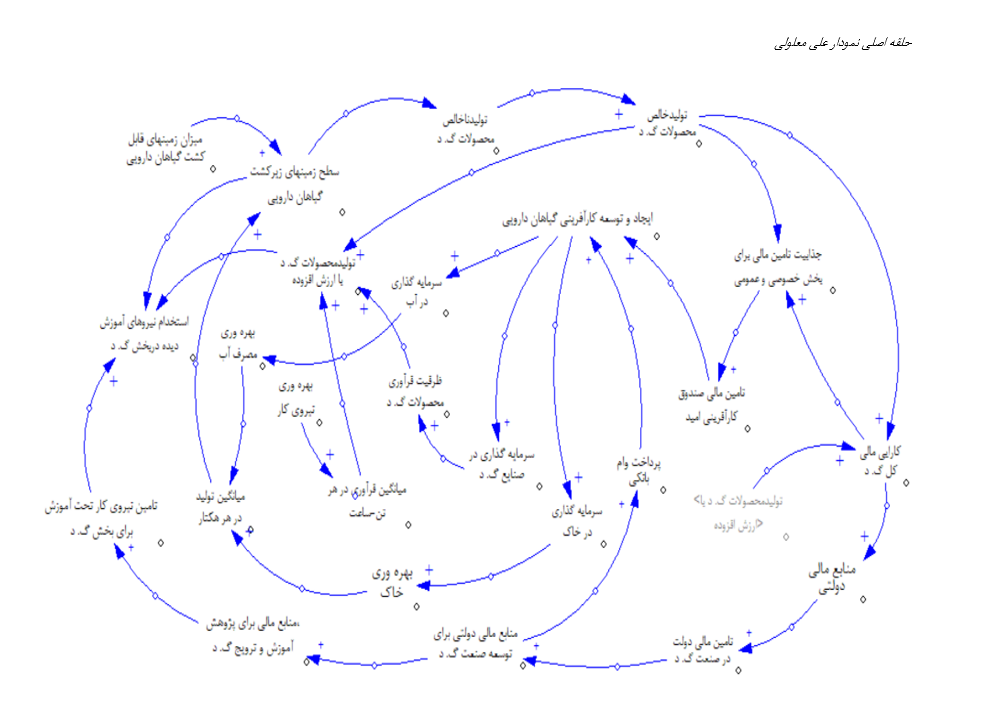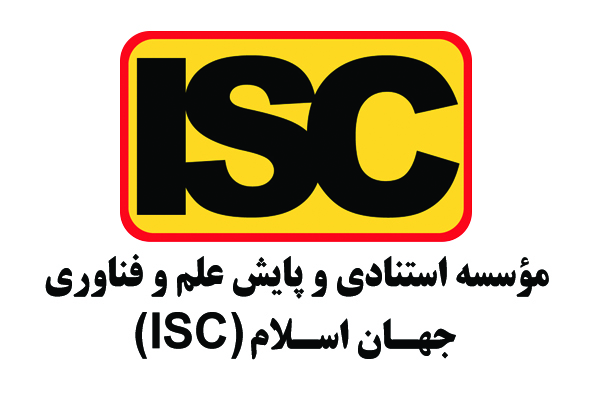تبیین مدل پویای اکوسیستم کارآفرینی صنعت گیاهان دارویی
کلمات کلیدی:
کارآفرینی, اکوسیستم کارآفرینی, گیاهان دارویی, پویایی سیستمچکیده
این پژوهش با هدف تبیین مدل پویای اکوسیسیتم کارآفرینی صنعت گیاهان دارویی تلاش دارد تا با ارتقای شناخت پیچیدگیها و پویاییهای این صنعت به درک فرصتهای کارآفرینی موجود و ایجاد اشتغال و همچنین همچنین افزایش بهرهوری عوامل تولید که شامل زمینهای قابل کشت، منابع آب و سرمایه انسانی کمک کند. روش پژوهش حاضر، از نظر هدف توسعهای-کاربردی و از لحاظ نحوه گردآوری اطلاعات از نوع آمیخته(کمی و کیفی) اکتشافی است. ابتدا با مطالعه ادبیات موضوعی پژوهش، متغیرهای مرتبط شناسایی و سپس با بررسی پیشینههای پژوهش، نوع روابط بین متغیرها، استخراج گردید. در مرحله بعد برای تکمیل روابط بین متغیرهای مدل، مصاحبههای نیمه ساختاریافتهای با خبرگان صورت گرفت. و در آخر براساس پویایی سیستم، نمودار علی- معلولی این اکوسیستم طراحی گردید. جامعه پژوهش موردبررسی، کارآفرینان صنعت گیاهان دارویی در چارچوب اکوسیستم کارآفرینی میباشد. در یافتههای حاصل از تبیین مدل علی- معلولی پژوهش، پنج زیرسیستم اکوسیستم کارآفرینی بدین ترتیب شناسایی شدند: 1) زیرسیستم تولید و توسعه محصولات گیاهان دارویی، که جمعیت کشور را نیز مورد بررسی قرار میدهد. 2) زیرسیستم تامین مالی و سرمایهگذاری در توسعه گیاهان دارویی که تاثیرپذیری آنان از متغیرهای دیگری مانند نرخ ارز نیز مورد بررسی قرار گرفته است. 3) زیرسیستم توسعه اکوسیستم کارآفرینی، که سیاستهای حمایتی، فرصتهای کارآفرینی و بازاریابی را دربر میگیرد. 4) زیر سیستم بهرهوری عوامل تولید که شامل منابع آب و خاک و نیروی انسانی میباشد. و 5) زیرسیستم عوامل فرهنگی میباشد که بعد فرهنگی، برای برطرف نمودن شکاف پژوهشی که در این حوزه وجود داشته است، به مدل اضافه گردید. سپس متغیرهای اصلی در هر زیرسیستم و پیوندهای علّی آنها در زیرسیستمها و همچنین ارتباط زیرسیستمها با یکدیگر در قالب نمودار علی- معلولی، مدلسازی شدند. از دیگر شکافهای برطرف شده در پژوهش حاضر، بررسی اکوسیستم کارآفرینی گیاهان دارویی است که تاکنون به روش پویایی سیستم بررسی نشده است. همچنین ارائه شکل جدیدی از دسته بندیهای زیرسیستمها نیز نوآوری پژوهش حاضر میباشند. تمامی پنج دسته عوامل شناساییشده، دارای ارتباطات پیچیده با یکدیگر هستند که معمولا این ارتباط از نوع مستقیم بوده و با برقراری ارتباط مناسب بین متغیرهای این اکوسیستم، نهتنها بهبود در بهرهوری عوامل تولید که شامل زمینهای قابلکشت، منابع آب و سرمایه انسانی است، به دست میآید.، بلکه در سایه آن منفعتهای فردی برای کارآفرینان و منفعتهای اجتماعی برای جامعه حاصل میشود.
دانلودها
مراجع
Audretsch, D. B., Cunningham, J. A., Kuratko, D. F., Lehmann, E. E., & Menter, M. (2019). Entrepreneurial ecosystems:
economic, technological, and societal impacts. The Journal of Technology Transfer, 44(2), 313-325.
https://doi.org/10.1007/s11187-017-9953-8
Bouncken, R. B., & Kraus, S. (2022). Entrepreneurial ecosystems in an interconnected world: emergence, governance and
digitalization. Review of managerial science, 16, 1-14. https://doi.org/10.1007/s11846-021-00444-1
Corrente, S., Greco, S., Nicotra, M., Romano, M., & Schillaci, C. E. (2019). Evaluating and comparing entrepreneurial
ecosystems using SMAA and SMAA-S. The Journal of Technology Transfer, 44(2), 485-519.
https://doi.org/10.1007/s10961-018-9684-2
Davari, A., Sefidbari, L., & Baghersad, V. (2017). The Factors of Iran's Entrepreneurial Ecosystem Based on the Isenberg
Model. Entrepreneurship Development, 10(1), 101-120. https://jed.ut.ac.ir/article_62306_en.html
Dias, C. S. L., Rodrigues, R. G., & Ferreira, J. J. (2019). What's new in the research on agricultural entrepreneurship? Journal
of Rural Studies, 65, 99-115. https://doi.org/10.1016/j.jrurstud.2018.11.003
Ganjhu, R. K., Mudgal, P. P., & Maity, H. (2015). Herbal plants and plant preparations as remedial approach for viral diseases.
Virusdisease, 26, 225-236. https://doi.org/10.1007/s13337-015-0276-6
Hosseinzadeh, M., Samadi Foroushani, M., & Sadraei, R. (2022). Dynamic performance development of entrepreneurial
ecosystem in the agricultural sector. British Food Journal, 124(7), 2361-2395. https://doi.org/10.1108/BFJ-08-2021-0909
Isenberg, D. (2011). The entrepreneurship ecosystem strategy as a new paradigm for economic policy: Principles for cultivating
entrepreneurship. Presentation at the Institute of International & European Affairs,
Jafari-Sadeghi, V., Kimiagari, S., & Biancone, P. P. (2019). Level of education and knowledge, foresight competency and
international entrepreneurship: a study of human capital determinants in the European countries. European Business
Review, 32(1), 46-68. https://doi.org/10.1108/EBR-05-2018-0098
Jha, S. K. (2018). Entrepreneurial ecosystem in India: taking stock and looking ahead. IIMB Management Review, 30(2), 179-
https://doi.org/10.1016/j.iimb.2018.04.002
Keim, J. (2024). Depolarizing innovation: Dynamic policy implications for entrepreneurial ecosystems in second-tier European
regions. Junior Management Science (JUMS), 9(1), 1211-1240.
https://www.econstor.eu/bitstream/10419/290633/1/1884465242.pdf
Kirillova, O. V., Amirova, E. F., Kuznetsov, M. G., Valeeva, G. A., & Zakharova, G. P. (2020). Innovative directions of
agricultural development aimed at ensuring food security in Russia. Bio Web of Conferences, 17, 00068.
https://doi.org/10.1051/bioconf/20201700068
Kosasih, K. (2024). The Social Entrepreneurship Approach to Improve the Medicinal Efficient Wild Plants' Economic Value
in the Community. IJEBMR. https://doi.org/10.51505/IJEBMR.2024.8702
Martínez-Fierro, S., Biedma-Ferrer, J. M., & Ruiz-Navarro, J. (2020). Impact of high-growth start-ups on entrepreneurial
environment based on the level of national economic development. Business Strategy and the Environment, 29(3), 1007-
https://doi.org/10.1002/bse.2413
Mason, C. (2019). Entrepreneurial ecosystems: emerging research questions. Presentation to the 2019 ACERE Conference,
University of Technology, Sydney.
Motamedi Nia, Z., Movahed Mohammadi, S. H., Alambeygi, A., & Mahdizadeh, H. (2024). Elements of the Isenberg
Entrepreneurial Ecosystem Model in the Context of Agricultural Higher Education. Iranian Journal of Agricultural
Economics and Development Research, 55(1). https://ijaedr.ut.ac.ir/article_81833.html?lang=en
Noorhosseini, A., Fallahi, E., Allahyari, M. S., Qolizadeh, S., & Majlesi, S. (2017). Identifying Economic, Educational, and
Extension Activities Impacting the Development of Medicinal Plant Cultivation Areas: Comparing Entropy Weighting
and Triangular Fuzzy Delphi Methods. Agricultural Education and Extension Research Quarterly, 10(4), 1-12.
http://journals.srbiau.ac.ir/article_11672.html
Okereke, S. C., Ijeh, I. I., & Arunsi, U. O. (2017). Determination of bioactive constituents of Rauwolfia vomitoria Afzel
(Asofeyeje) roots using gas chromatography-mass spectrometry (GC-MS) and Fourier transform infrared spectrometry
(FT-IR). African J Pharm Pharmacol, 11, 25-31. https://doi.org/10.5897/AJPP2016.4712
Pariasa, I. I., & Hardana, A. E. (2024). The Impact of Farm Production Factors on The Income of Horticultural Farmers in East
Java. HABITAT, 35(1), 19-30. https://doi.org/10.21776/ub.habitat.2024.035.1.3
Rao, B. R., Batni, A. R., & Shrivastava, P. (2024). Fostering Agriculture Ecosystem for Sustainability. In Digital Agricultural
Ecosystem: Revolutionary Advancements in Agriculture (pp. 211-228). https://doi.org/10.1002/9781394242962.ch12
Rathore, R. (2022). Entrepreneurial behavior of farmers towards cultivation of medicinal and aromatic plants in the Ujjain
district of Madhya Pradesh. Indian Research Journal of Extension Education, 22(4), 64-67.
https://doi.org/10.54986/irjee/2022/oct_dec/64-67
Reyisi, A., Shiehki Tash, M., Salarzehi, H., & Vali Nafs, A. (2016). Identifying and Prioritizing Factors Influencing
Agricultural Entrepreneurship Development in Rural Areas (Case Study: Sarbaz County).
Shwetzer, C., Maritz, A., & Nguyen, Q. (2019). Entrepreneurial ecosystems: a holistic and dynamic approach. Journal of
Industry-University Collaboration, 1(2), 79-95. https://doi.org/10.1108/JIUC-03-2019-0007
Stam, E., & Van de Ven, A. (2021). Entrepreneurial ecosystem elements. Small Business Economics, 56, 809-832.
https://doi.org/10.1007/s11187-019-00270-6
Stam, F. C., & Spigel, B. (2016). Entrepreneurial ecosystems. USE Discussion paper series, 16(13).
https://ideas.repec.org/p/use/tkiwps/1613.html
Sterman, J. (2000). Business Dynamics: Systems Thinking and Modeling for a Complex World. Irwin/McGraw-Hill.
plex_World
Tang, O., & Rehme, J. (2017). An investigation of renewable certificates policy in Swedish electricity industry using an
integrated system dynamics model. International Journal of Production Economics, 194, 200-213.
https://doi.org/10.1016/j.ijpe.2017.03.012
Urgessa, O. (2024). Effects of real effective exchange rate volatility on export earnings in Ethiopia: symmetric and asymmetric
effect analysis. Heliyon, 10. https://doi.org/10.1016/j.heliyon.2023.e23529
Worku, M. (2023). Production, productivity, quality and chemical composition of Ethiopian coffee. Cogent Food Agric, 9.

دانلود
چاپ شده
ارسال
بازنگری
پذیرش
شماره
نوع مقاله
مجوز
حق نشر 2025 تکنولوژی در کارآفرینی و مدیریت استراتژیک

این پروژه تحت مجوز بین المللی Creative Commons Attribution-NonCommercial 4.0 می باشد.










